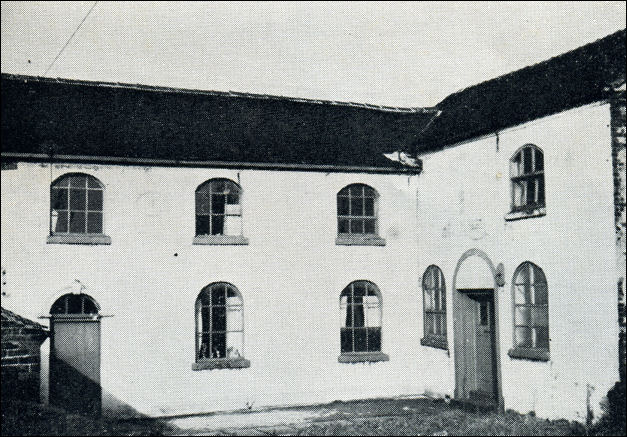![]()
|
|
|
|
|
Stoke-on-Trent - photo of the week |

Harriseahead Primitive Methodist - old chapel
|
The link with Methodism came when Hugh
Bourne moved to Harriseahead in 1800 having bought an oak woodland there
to supply pit props in Stonetrough Colliery and other local mines. In 1801 to 1802 he built a Methodist Chapel which became the centre of Methodist activity in that area and beyond. The Primitive Methodist movement grew out of this.
Harriseahead original Primitive Methodist Chapel built by Hugh Bourne (1802) now used as a work shed with only a few parts of the original walls remaining. The upper window sills may be seen. The nearest arch, showing an architectural feature typical of Primitive Methodist Chapels, would have been a doorway as can be seen in the top photo. photo: April 2007 R. J. Higginson
The Religious Significance of the Harriscahead and Mow Cop Revival By the Rev. Dr. W. E. Farndale "This revival (the beginning of which we
may date as from 1800 to 1802) was the root from which sprang the Mow Cop
Camp Meeting of May 1807. About 1800 Hugh Bourne, himself a convert of only a year's standing, found himself during his daily work confronted by the pagan plight of the two mining villages of Harriseahead and Mow Cop. The Anglicans were making no saving impact, as Bourne would testify from previous long attendance at a parish church in the vicinity. The Methodists had only one solitary representative in the area, old Jane Hall. There was no Methodist chapel. Open-air preaching had ceased : Bourne said " I never knew a Burslem travelling preacher perform what Mr. Wesley called field preaching all the time I was a member." At Dales Green, however, not far away, a local preacher named Allen had ventured to engage in outdoor preaching, and a miner named Matthias Bayley had been converted. But generally men, women and children knew nothing of the redemptive grace of God in Christ. And no one seemed to care ! How came such an appalling state to exist ? Possibly one factor was the absorption at that time of Methodists in complex constitutional problems into which the death of John Wesley only nine years-previously had thrust them. Further, the phenomenal multiplication of industrial town populations had given such centres priority in the distribution of ministers. The countryside was having much less care than in the earliest days of Methodism.
At the very core of this revival was a firm out-working belief in the efficacy of prayer as a converting force. Within two years Bourne, Bayley, Shubotham and the growing band of prayer warriors had brought into membership eighty converts, and had seen a chapel erected as a gift by Bourne at Harriseahead, with regular attendances of two hundred. And all this in a locality with a sparse and scattered population, and through the efforts of laymen alone who in their earnest, humble way had on their knees pleaded the promises. As time went on, many others joined them but these men had stamped the indelible prayer-pattern on the movement. What a preparation for the Pentecost on Mow Cop that inevitably followed ! Our aim surely must be, not merely to celebrate the wondrous success of their method, but to catch the contagion of their spirit. To Hugh Bourne, the human originator of this revival movement, one Bible verse was inexpressibly dear and potent. That oracle summoned him to loving, uttermost obedience to every command of Christ, and assured him of the glorious, naming self-unveiling by the Lord of His constant presence and power. Mow Cop, 1957, can be to us a Pathway of Power on the terms of Bourne's most precious text - the one that brought him to Christ, the one that nerved him to hold fast in the storms of opposition in 1807, and which was the theme of his last sermon on Sunday, January 22, 1852. For fifty years it was his lodestar. It enabled him to toil until, at his passing he left behind 109,984 pledged Methodist members. What was this stimulating Word of God ? You can read it in John 14 : 21. That same word can prove as mighty now as then!"
|